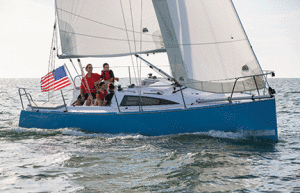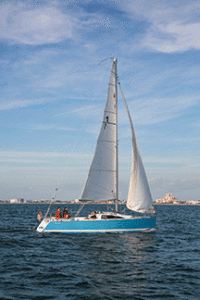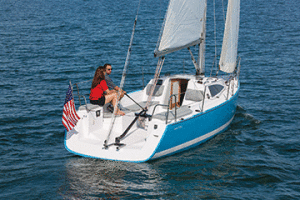 Catalina Reinvents the Sport Cruiser
Catalina Reinvents the Sport Cruiser
As we motored the new Catalina 275 out of Annapolis and into the Chesapeake Bay on a cloudy almost windless afternoon that was threatening showers, I felt the liveliness of the tiller and rudder in my hand as the prop wash from the sail drive unit flowed by it and knew that we were on a new, very different Catalina. Clear of the channel, we hoisted the full battened mainsail and rolled out the self-tacking jib. With the engine shut down, we close reached across the mouth of the Severn River and then hardened up to sail close to the wind. The 275 handled easily and once we had her on the wind found that she was very close winded and showed a real ability to sail fast.
The main sheet runs to a traveler in the cockpit that is handy to the helmsman so one person can steer and trim the big sail at the same time. The jib sheet runs through a traveler on the cabin top before the mast; the trick in this arrangement is to avoid over trimming the sheet since it is easy to haul it in too tightly and close the slot. After a couple of tacks, you get to appreciate just how finely tuned the rig can be and how adaptable it is for varying wind strengths.
The idea that designer Gerry Douglas was working with for the 275 was to make it simple to sail but endowed with a good turn of speed. The 275 is definitely a dual purpose boat that will be great weekending but also a lot of fun to race one design or in mixed PHRF fleets.
To gain the performance off the wind, where the self tacking jib is not as effective, you need to be able to fly a reacher or cruising chute easily. The system Douglas came up with, working with Selden Spars, was to have a Selden demountable bowsprit fitted as standard equipment. From this you fly a reacher that is controlled with a Selden top-down furling system.
During our sail trial in Annapolis, after we had sailed close hauled for a while and thrown the 275 through a series of tacks, we fell off the wind, rolled up the jib and rolled out the big red, white and blue reacher. It was a simple operation that two people can manage easily.
The result was a pleasing acceleration despite the lightness of the breeze. We broad reached toward the deep water of the bay and then jibed back and forth. Hauling the big sail around the headstay with each jibe took a bit of coordination and timing but little strength. The helmsman can jibe the mainsail while the lone crew can jibe the reacher. No problem.
There were four men aboard that afternoon, which is normally a lot to fit into the cockpit of a 27-footer. But we were all able to move about the cockpit trimming sails, steering, and making tacks and jibes without bumping into each other. And, as we sailed on long tacks we were able to settle down comfortably without banging shins or huddling together.
 One unique design feature in the cockpit is the raised helmsman’s seats aft where he or she can sit slightly elevated from the bench seats to improve both visibility and comfort.
One unique design feature in the cockpit is the raised helmsman’s seats aft where he or she can sit slightly elevated from the bench seats to improve both visibility and comfort.
Three or four people will be the standard crew for most racing situations and the boat will be excellent for a family with two adults and two or even three kids to have fun racing against their peers. The plan is for dealers to offer to set up one design fleets and then build a national association so there can be regional and then national regattas.
But the 275 is also a nifty little weekender that will be fun for the whole family overnighting in some pretty coves. In a real sense, the 275 is a throwback to the dual purpose boats in this size range that made MORC racing (Midgit Ocean Racing Class) so popular in the sixties and seventies. Small racer-cruisers that were affordable brought families together and gave them a platform for competition and simple cruising. It is fun to do both, after all.
DESIGN DETAILS
Douglas started out with a long waterline for optimal boat speed. The 275 is 27 feet, six inches overall and has a 26-foot, seven inch waterline. This will translate into a nominal hull speed of seven knots, which is not bad for a boat of this size.
But the 275 weighs only 5,000 pounds and 40 percent of that is in the fin keel, so it is both very stiff and the hull is very light for a production boat. Plus, the aft sections of the hull are quite flat and the full eight foot, six inch beam is carried almost all the way aft. This combination means that the boat will be able to plane in the right conditions and can have breakaway speeds of 10 to 12 knots or more.
The narrow beam means the boat can be trailered from cruising ground to racing venue behind a standard family SUV. The standard fin keel that creates a total of five feet of draft enhances windward performance and makes the boat feel much larger and more stable than you might initially think when you step aboard.
 The moderately high aspect rudder will perform well and give a very positive feel to the helm. Steering with a tiller and a short tiller extension, the 275 feels well balanced and steers surely and very lightly. The open transom enlarges the cockpit and provides a built in swim platform and a place for landing the dinghy. The telescoping swim ladder fits neatly right next to the adjustable backstay.
The moderately high aspect rudder will perform well and give a very positive feel to the helm. Steering with a tiller and a short tiller extension, the 275 feels well balanced and steers surely and very lightly. The open transom enlarges the cockpit and provides a built in swim platform and a place for landing the dinghy. The telescoping swim ladder fits neatly right next to the adjustable backstay.
One small detail that often comes up is the question of, “Where are the drink holders?” Douglas has heard this at boat shows for many years and knows that such a small detail can make the difference for some prospective buyers. And, he knows that even racers like a cool beverage while sailing from time to time. So, he created a folding double drink holder that disappears under the mainsheet traveler when not in use.
CRUISING LIFE
As a compact weekender the 275 packs a lot into a small package. Down below, the boat has bench seats forward with a small wood table between them that are fine single berths. At bedtime, couples who want a double berth can lower the table to accommodate a filler cushion that transforms the forward part of the cabin into a large V-berth. A 27-footer does not normally have a lot of storage for clothes and personal gear so Douglas came up with the idea of creating portable gear bags with handles that can be hung behind the settee seats as back rests.
The idea is one of simple organization: you can take the bags home with you and fill them, then upon your return to boat you can simply hang them up. Aft and to starboard there is a long, wide single berth where the largest crewmember can sleep. But it also is designed to be big enough to accommodate a couple of stand up paddleboards or a kayak.
The 275 has a small modular galley with a sink and place for a portable stove. Across from it is the enclosed head with its own holding tank, which are standard on all boats. For a weekend away, the 275 will be comfortable for a couple or a small family. The cockpit is huge and will be the main living area while the cabin is roomy enough for evening meals, games and reading before lights out.
BWS THOUGHTS
Catalina has been designing solid, well-built and practical boats for cruisers and racers for 40 years and has always remained current with the design trends and styles of the times. The new 275 is a long step toward the future for the company and we can see that there is huge potential for the boats to gain a wide and avid following. For thirty-somethings who are ready to own their own boats for racing and cruising and for sixty-somethings who are ready to scale back from big boat sailing, the 275 comes in at the right size and the right price for the job.
Catalina 275 Sport
LOA 27’6”
LWL 26’7”
Beam 8’6”
Draft 5’0”
Displ. 5,000 lbs.
Ballast 2,040 lbs.
Sail area 380 sq. ft.
Mast height 39’0”
Catalina Yachts
Largo, FL andWoodland Hills, CA
Ph: 727-544-6681
www.catalinayachts.com















